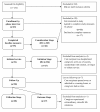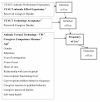Stages of use: consideration, initiation, utilization, and outcomes of an internet-mediated intervention
- PMID: 21092275
- PMCID: PMC3000372
- DOI: 10.1186/1472-6947-10-73
Stages of use: consideration, initiation, utilization, and outcomes of an internet-mediated intervention
Abstract
Background: Attrition, or nonuse of the intervention, is a significant problem in e-health. However, the reasons for this phenomenon are poorly understood. Building on Eysenbach's "Law of Attrition", this study aimed to explore the usage behavior of users of e-health services. We used two theoretical models, Andersen's Behavioral Model of Health Service Utilization and Venkatesh's Unified Theory of Acceptance and Use of Technology, to explore the factors associated with uptake and use of an internet-mediated intervention for caregivers taking care of a family member with dementia.
Methods: A multiphase, longitudinal design was used to follow a convenience sample of 46 family caregivers who received an e-health intervention. Applying the two theories, usage behavior was conceptualized to form four stages: consideration, initiation, utilization (attrition or continuation), and outcome. The variables and measurement scales were selected based on these theories to measure the sociodemographic context, technology aptitudes, and clinical needs of the caregivers.
Results: In the Consideration Stage, caregivers who felt that the information communication technology (ICT)-mediated service was easy to use were more likely to consider participating in the study (p = 0.04). In the Initiation Stage, caregivers who showed greater technology acceptance were more likely to initiate service earlier (p = 0.02). In the Utilization Stage, the frequent users were those who had a more positive attitude toward technology (p = 0.04) and a lower perceived caregiver competence (p = 0.04) compared with nonusers. In the Outcome Stage, frequent users experienced a decline in perceived burden compared with an escalation of perceived burden by nonusers (p = 0.02).
Conclusions: We illustrate a methodological framework describing how to develop and expand a theory on attrition. The proposed framework highlighted the importance of conceptualizing e-health "use" and "adoption" as dynamic, continuous, longitudinal processes occurring in different stages, influenced by different factors to predict advancement to the next stage. Although usage behavior was influenced mainly by technological factors in the initial stages, both clinical and technological factors were equally important in the later stages. Frequency of use was associated with positive clinical outcomes. A plausible explanation was that intervention benefits motivated the caregivers to continue the service and regular use led to more positive clinical outcome.
Figures
Similar articles
-
Theorizing the health service usage behavior of family caregivers: a qualitative study of an internet-based intervention.Int J Med Inform. 2011 Nov;80(11):754-64. doi: 10.1016/j.ijmedinf.2011.08.010. Epub 2011 Sep 29. Int J Med Inform. 2011. PMID: 21958550
-
The TECH@HOME study, a technological intervention to reduce caregiver burden for informal caregivers of people with dementia: study protocol for a randomized controlled trial.Trials. 2017 Feb 9;18(1):63. doi: 10.1186/s13063-017-1796-8. Trials. 2017. PMID: 28183323 Free PMC article. Clinical Trial.
-
Co-construction of an Internet-based intervention for older assistive technology users and their family caregivers: stakeholders' perceptions.Disabil Rehabil Assist Technol. 2019 Aug;14(6):602-611. doi: 10.1080/17483107.2018.1499138. Epub 2018 Oct 14. Disabil Rehabil Assist Technol. 2019. PMID: 30318939
-
Do Technology-Based Support Groups Reduce Care Burden Among Dementia Caregivers? A Review.J Evid Inf Soc Work. 2015;12(5):474-87. doi: 10.1080/15433714.2014.930362. Epub 2015 Mar 20. J Evid Inf Soc Work. 2015. PMID: 25794367 Review.
-
Internet-Based Supportive Interventions for Family Caregivers of People With Dementia: Systematic Review and Meta-Analysis.J Med Internet Res. 2020 Sep 9;22(9):e19468. doi: 10.2196/19468. J Med Internet Res. 2020. PMID: 32902388 Free PMC article.
Cited by
-
Usefulness of a Tailored eHealth Service for Informal Caregivers and Professionals in the Dementia Treatment and Care Setting: The eHealthMonitor Dementia Portal.JMIR Res Protoc. 2016 Apr 5;5(2):e47. doi: 10.2196/resprot.4354. JMIR Res Protoc. 2016. PMID: 27050401 Free PMC article.
-
Computerised therapy for depression with clinician vs. assistant and brief vs. extended phone support: study protocol for a randomised controlled trial.Trials. 2012 Aug 27;13:151. doi: 10.1186/1745-6215-13-151. Trials. 2012. PMID: 22925596 Free PMC article. Clinical Trial.
-
A group- and smartphone-based psychological intervention to increase and maintain physical activity in patients with musculoskeletal conditions: study protocol for a randomized controlled trial ("MoVo-App").Trials. 2020 Jun 8;21(1):502. doi: 10.1186/s13063-020-04438-4. Trials. 2020. PMID: 32513291 Free PMC article.
-
Factors Influencing the Adoption of Smart Health Technologies for People With Dementia and Their Informal Caregivers: Scoping Review and Design Framework.JMIR Aging. 2019 Apr 30;2(1):e12192. doi: 10.2196/12192. JMIR Aging. 2019. PMID: 31518262 Free PMC article.
-
Engagement in a web-based intervention for individuals who committed sexual offenses against children: observational study.BMC Psychol. 2025 Jan 20;13(1):59. doi: 10.1186/s40359-025-02366-z. BMC Psychol. 2025. PMID: 39833921 Free PMC article.
References
-
- Brouwer W, Oenema A, Crutzen R, de Nooijer J, de Vries NK, Brug J. An exploration of factors related to dissemination of and exposure to internet-delivered behavior change interventions aimed at adults: a Delphi study approach. J Med Internet Res. 2008;10:e10. doi: 10.2196/jmir.956. - DOI - PMC - PubMed
Publication types
MeSH terms
Grants and funding
LinkOut - more resources
Full Text Sources
Medical




